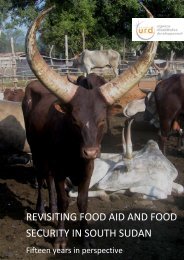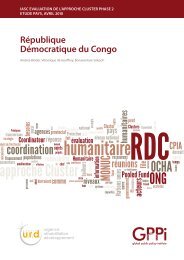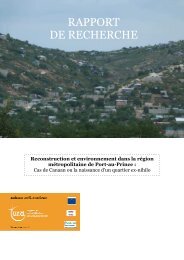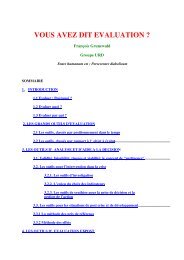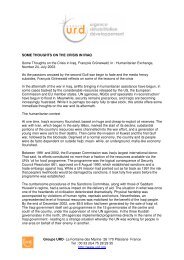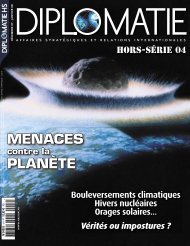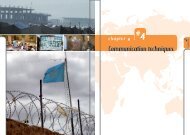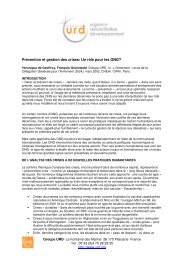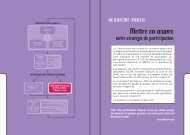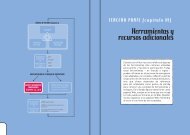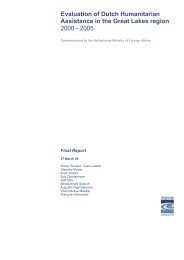Kabul Urban Survey - Groupe URD
Kabul Urban Survey - Groupe URD
Kabul Urban Survey - Groupe URD
Create successful ePaper yourself
Turn your PDF publications into a flip-book with our unique Google optimized e-Paper software.
6.2 Different level of spatial reconstruction strategies<br />
6.2.1 Rehabilitation projects<br />
• Rehabilitation and historical issues (guidelines)<br />
The history of the city is one of the main components for understanding present urban issues<br />
and should be the first step in any assessment. <strong>Kabul</strong> is an old city. The buildings, even<br />
illegal or informal housing are built relatively well with a general sense of coherence as local<br />
materials are used which are adapted to the climate and most houses have been built in a<br />
traditional way. The lack of development over several decades has to a certain extent<br />
preserved a <strong>Kabul</strong>i identity in terms of the urban structure and buildings. Knowledge about<br />
patterns and historical urban development plays an important role in preserving the<br />
traditional Afghan way of life besides the obvious need for modernisation. After the trauma<br />
that the Afghan population has suffered, it is important that some traditional aspects are<br />
preserved in their new urban life. The issue of identity is of great importance and deserves<br />
some thorough investigation, such as:<br />
- Within the MoUDH, a widespread survey has been conducted by Zahra Breshna. The<br />
“Program for the Safeguarding & Development of Historical <strong>Kabul</strong>” aimed to propose an<br />
urban framework for preserving <strong>Kabul</strong> city centre from anarchic development by private<br />
investors and businesses 50 .<br />
- Architectural issues and cultural identity have been the subject of study programmes in<br />
1975 with Nancy Dupree 51 , in 1986 by Kazimee Bashir with “Traditional Housing<br />
Patterns: The old City of <strong>Kabul</strong> Afghanistan 52 ”, and some of the architects 53 from the Aga<br />
Khan Foundation, who have been very much involved in preserving architectural heritage<br />
within the “Agar Khan Trust for Culture” AKTC in <strong>Kabul</strong> (and Herat).<br />
• <strong>Kabul</strong> <strong>Urban</strong> Reconstruction Project (KURP)<br />
The needs for rehabilitation in the city are so huge and funds limited, that a lot of analysis,<br />
workshops, meetings and surveys have been necessary to help in the decision-making<br />
process regarding priorities and spatial implementation. Since 2004, the <strong>Kabul</strong> <strong>Urban</strong><br />
Reconstruction Project has been monitoring a long process of negotiation between the<br />
different stakeholders, mainly the Ministry of <strong>Urban</strong> Development and <strong>Kabul</strong> Municipality, in<br />
presence of the main donor: the World Bank. UN-HABITAT holds a permanent advisory role.<br />
The Ministry of Finance (MoF) and the Ministry of Interior (MoI) are also directly involved.<br />
Different surveys have been conducted by World Bank technical staff and consultants, by the<br />
KURP Unit Team within the MUDH and by <strong>Kabul</strong> Municipality before the last accord of July<br />
2006. Among the documents available for this survey:<br />
- The Energy and Infrastructure Unit within the South Asia Region Department of the<br />
World Group Bank prepared in June 2004 a financial proposal for <strong>Kabul</strong>’s urban<br />
reconstruction issues with “Technical Annex for a proposed credit of SDR 17,1 million to<br />
Islamic Republic of Afghanistan for a <strong>Kabul</strong> <strong>Urban</strong> Reconstruction Project”. 54<br />
50 Breshna Z., MoUDH, Program for the Safeguarding & Development of Historical <strong>Kabul</strong>, Proposal for<br />
phase 1 of Implementation May 2005-0ctober 2005, <strong>Kabul</strong>, 2005. Presented by HE.Eng.M. Yousuf<br />
Pashtun, Minister of <strong>Urban</strong> development & Housing.<br />
51 Dupree N.H., “<strong>Kabul</strong> City” - The Asia Society -The Afghanistan Council, New York, 1975<br />
52 Bashir A. Kazimee, “Traditional Housing Patterns: The old City of <strong>Kabul</strong> Afghanistan”, in Open<br />
House International Vol.11 N°1, 1986<br />
53 Najimi A. W., AKTC, “Preservation and revival of cultural identity”, Shadl M., AKTC, “Historic notes<br />
on <strong>Kabul</strong>” and Soave A., AKTC, “The historical neighbourhoods of <strong>Kabul</strong>: Planning efforts and<br />
negotiation processes”, all texts produced in Development of <strong>Kabul</strong> –Reconstruction and planning<br />
issues, issued for the colloquium organised by MUNTAZ & NOSHIS, Lausanne 2004<br />
54 World Bank, June 2004, “Technical Annex for a proposed credit of SDR 17,1 million to Islamic<br />
Republic of Afghanistan for a <strong>Kabul</strong> <strong>Urban</strong> Reconstruction Project”. Energy and Infrastructure Unit,<br />
South Asia Region<br />
Page 66



